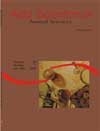<b>Development of a functional approach in a grassland vegetation</b> - DOI: 10.4025/actascianimsci.v30i2.4679
Resumo
To improve our understanding of grassland dynamics under different levels of utilization, a functional description of the vegetation was introduced in a deterministic model. The selected traits and their parameterization were based on the results of a long-term experiment in which temperate grasslands were managed for 12 years with three levels of herbage use: high, medium and low. The integration of functional attributes of the community species within the model’s parameters can be seen as a new step in the study of the grassland ecosystem. With this tool, it is possible to decrease the number of interconnections in the system and consequently decrease the complexity. In this work a, functional definition of three different grassland communities was introduced into the sub-vegetation model. This was done by interchanging the model’s parameters with the functional attributes of the communities. From the conceptual point of view, the sub-vegetation model works adequately and it seems suitable to simulate the dynamic of grassland vegetation described by functional traits. The model fits experimental data well for high levels of utilization, but was poorly adjusted at medium and low levels of herbage use. We believe this is due to a better simulation of green biomass fluxes than for senescence or reproductive fluxes. Some possible improvements of the model are discussed.Downloads
DECLARAÇÃO DE ORIGINALIDADE E DIREITOS AUTORAIS
Declaro que o presente artigo é original, não tendo sido submetido à publicação em qualquer outro periódico nacional ou internacional, quer seja em parte ou em sua totalidade.
Os direitos autorais pertencem exclusivamente aos autores. Os direitos de licenciamento utilizados pelo periódico é a licença Creative Commons Attribution 4.0 (CC BY 4.0): são permitidos o compartilhamento (cópia e distribuição do material em qualqer meio ou formato) e adaptação (remix, transformação e criação de material a partir do conteúdo assim licenciado para quaisquer fins, inclusive comerciais.
Recomenda-se a leitura desse link para maiores informações sobre o tema: fornecimento de créditos e referências de forma correta, entre outros detalhes cruciais para uso adequado do material licenciado.








































